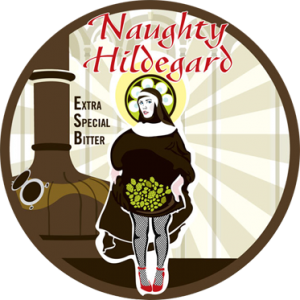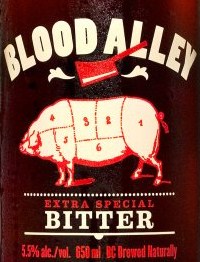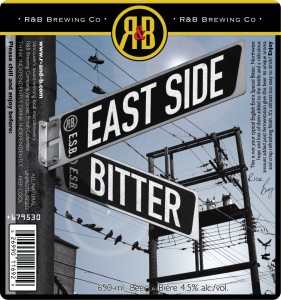Author
Derek Hyde
Share
What’s a West-Coast E.S.B.? It could simply be considered as an E.S.B. that’s brewed on the west coast, though more recent examples are typically a little stronger in alcohol, bitterness, hop flavour and aroma.
The first widely distributed modern example may have been Rogue’s Brutal Bitter. With a complex malt bill, 59 IBU and about 5.9% abv (15P and 76%AA), this ‘extreme’ bitter pushed the boundaries of the style. They’ve actually recently renamed it “Brutal IPA”. Whatever they call it, it’s still a great brew and has almost sold out at the LCBO once again.
As for BC brewers, Howe Sound Brewing was one of the first to market a hopped-up Bitter. They’ve had the “Bailout Bitter” (5%) as well as the Baldwin and Cooper Best Bitter (now 5.5%). Around the same time, Central City had their Boomer’s Red Ale (5.5%), and they now sell the Red Racer ESB (6.5%) in cans. These examples seem to have a light residual sweetness from the malt, but it’s still over-powered by the bitterness from the west-coast hopping.
Driftwood brought their Naughty Hildegard back this year, though now it has British hops. This one’s 6.5% abv and 70 IBU, which is admittedly bordering on an IPA, but that’s how they do things on the west coast. For comparison, try their Fat Tug IPA, which packs 7% abv and 80 IBUs.
 A more recent addition from Russell Brewing is the Blood Alley Bitter. An interview with the brewmaster on the Vancouver Beer Blog reveals the addition of crystal malts, a bit of chocolate malt for colour and flaked barley for body. The boil is finished with Columbus and it’s dry-hopped with Cascade & Willamette. The result is an incredibly well crafted brew. It’s somewhat similar in character to Rogue’s Brutal, with a plethora of hop flavour and aroma, but slightly lighter in alcohol & bitterness (5.5% abv and 50 IBU).
A more recent addition from Russell Brewing is the Blood Alley Bitter. An interview with the brewmaster on the Vancouver Beer Blog reveals the addition of crystal malts, a bit of chocolate malt for colour and flaked barley for body. The boil is finished with Columbus and it’s dry-hopped with Cascade & Willamette. The result is an incredibly well crafted brew. It’s somewhat similar in character to Rogue’s Brutal, with a plethora of hop flavour and aroma, but slightly lighter in alcohol & bitterness (5.5% abv and 50 IBU).
 The newest release is R&B’s East Side Bitter. At only 4.5% abv, this one is a seriously sessionable hop fix. Although the west-coast hopping may be extra special, the strength and bitterness are really closer to a Best/Special Bitter.
The newest release is R&B’s East Side Bitter. At only 4.5% abv, this one is a seriously sessionable hop fix. Although the west-coast hopping may be extra special, the strength and bitterness are really closer to a Best/Special Bitter.
So what’s the difference is between an E.S.B., Pale Ale and I.P.A.? If you don’t care, stop reading now… but if your inner geek can’t resist, here’s some style guidelines:
The BJCP has the English Pale Ales, comprising Standard/Ordinary Bitter, Special/Best/Premium Bitter and Extra Special/Strong Bitter. American Ale is a peculiar mix of Pale, Amber and Brown Ale, while the IPAs are found in a separate category.
Alternatively, in Designing Great Beers Ray Daniels has separated the Bitters (Ordinary, Best/Special and Strong/Extra-Special) and the Pale Ales (English, American and India), based on the 1995 National Homebrew Competition Guidelines. This segregation of Bitters and Pale Ales is still seen in the current Brewers Association 2011 Beer Style Guidelines. They have a really nice description for E.S.B. listed under “British Origin”:
Extra special bitter possesses medium to strong hop aroma, flavor, and bitterness. The residual malt and defining sweetness of this richly flavored, full-bodied bitter is more pronounced than in other styles of bitter. It is light amber to copper colored with medium to medium-high bitterness. Mild carbonation traditionally characterizes draft-cask versions, but in bottled versions, a slight increase in carbon dioxide content is acceptable. Fruity-ester character is acceptable in aroma and flavor. Diacetyl (butterscotch character) is acceptable and characteristic when at very low levels. The absence of diacetyl is also acceptable. Chill haze is allowable at cold temperatures. English or American hops may be used. (English and American hop character may be specified in subcategories.)
Original Gravity (ºPlato) 1.046-1.060 (11.5-14.7 ºPlato) ● Apparent Extract/Final Gravity (ºPlato) 1.010-1.016 (2.5-4 ºPlato) ● Alcohol by Weight (Volume) 3.8-4.6% (4.8-5.8%) ● Bitterness (IBU) 30-45 ● Color SRM (EBC) 8-14 (16-28 EBC)
The West-Coast E.S.B.’s could certainly be considered a sub-category of E.S.B., as defined by the Brewers Association. But while they typically include American (west coast) hops, they’re often a little stronger in alcohol and bitterness as well.
So how’s that different from an I.P.A.? Well, they typically have less alcohol than a West-Coast I.P.A., but have a more complex malt bill (and still finish relatively dry).
Basically, they’re an E.S.B. that’s brewed on the west coast.
Like hops?